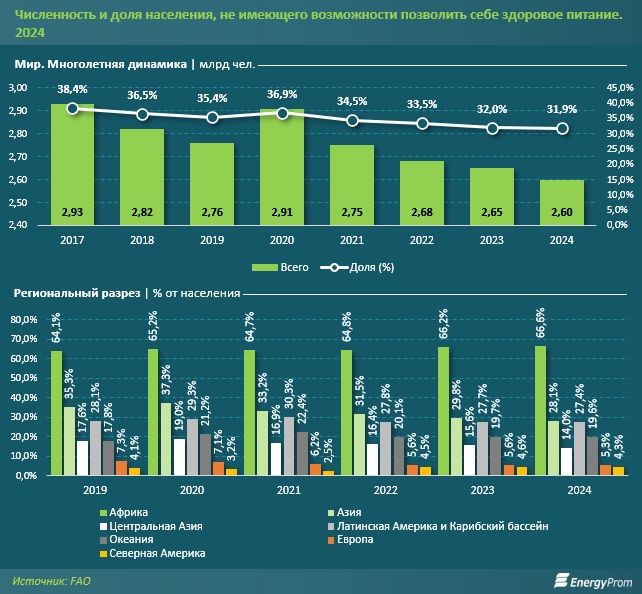FAO: Nearly One-Third of the Global Population Cannot Afford a Healthy Diet

FAO defines a healthy diet as one that provides 2330 kcal per day with an adequate balance of six main food groups: starchy foods, vegetables, fruits, animal products, oils, and legumes.
The largest number of people deprived of access to a healthy diet reside in Asia — 1.35 billion people (28.1% of the region's population). In Africa, the proportion of undernourished remains the highest — more than 1 billion people, or two-thirds of the continent's population.
Latin America and the Caribbean account for 181.9 million people (27.4%), while Europe and North America have the lowest figures — 5.3% and 4.3% respectively.
The average cost of a healthy diet worldwide, considering purchasing power parity (PPP), was $4.46 per person per day. The highest cost was noted in Latin America ($5.1), while the lowest was in North America and Oceania (about $3.85).
In Central Asia, the number of people without access to a healthy diet decreased fr om 12.6 million in 2023 to 11.5 million in 2024. The average cost of a healthy diet by PPP in the region was $3.78, down from the previous year ($3.81).
In terms of undernourishment, Central Asia is among the most prosperous regions in the world — 2.9% of the population, which is 2.5 times lower than the average for Asia and almost three times lower than the global level (8.5%).
According to the FAO report, in Kazakhstan and Uzbekistan, the level of undernourishment is less than 2.5%, which is the lowest not only in Central Asia but also globally. For comparison: in Turkmenistan — 4.3%, Kyrgyzstan — 5.1%, Tajikistan — 8.4%.
Data from the Bureau of National Statistics of Kazakhstan confirm this trend: only 3.2% of respondents reported experiencing an inability to eat healthy food due to lack of money over the past year. Only 0.7% of respondents stated they had experienced hunger at least once.
The prevalence of acute malnutrition in children under 5 years in Central Asia is 2.1%, which is three times lower than the global average (6.6%).
The lowest rate is in Kazakhstan (data <4.4%) and Uzbekistan (2.4%), while the highest is in Tajikistan (6.4%).
The prevalence of stunted growth in children, reflecting chronic malnutrition, is 23.2% globally, while in Central Asia it is only 7.4%.
FAO notes the beginning of a transition in the region to a 'double burden of malnutrition' — wh ere deficiency and excess coexist in one country. In Central Asia, 6.4% of children under 5 are overweight, which is above the global average (5.5%). In Kyrgyzstan — almost 10%, in Kazakhstan — 8.7%, indicating emerging risks associated with lifestyle and dietary changes.












